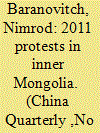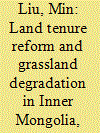| Srl | Item |
| 1 |
ID:
144545


|
|
|
|
|
| Summary/Abstract |
In May 2011, Inner Mongolia experienced the most serious ethnic unrest in the region for 30 years. In this article, I explore the broader context that led to the eruption of the protests, with a particular emphasis on environmental issues. My aim is to explain why environmental issues occupied such a prominent position in the protests, and how these issues were connected to ethnicity. After discussing the material and practical implications of grassland degradation for Mongolian herders, I analyse the symbolic implications of this environmental crisis for the Mongolian educated elite, who have linked environmental issues to ethnic politics and identity. I argue that in the last 20 years or so, Mongolian intellectuals have developed a highly ethnicized environmental discourse, and that this discourse played an important role in informing the 2011 protests. My analysis focuses on this discourse as it is manifested in the domains of art, academia and daily discourse.
|
|
|
|
|
|
|
|
|
|
|
|
|
|
|
|
| 2 |
ID:
168351


|
|
|
|
|
| Summary/Abstract |
Since the start of the land tenure reform in the pastoral areas of China in the 1980s, grassland use rights have increasingly been assigned to individual households. However, this period has also been accompanied by extensive grassland degradation in China, which has raised the question of whether a tragedy of privatisation has occurred. This paper investigates the impact of land tenure reform on the changes in grassland condition, using data from 60 counties in Inner Mongolia between 1985 and 2008. A fixed effects model is employed to control for time-invariant factors. Two alternative model specifications in terms of land tenure reform and time-variant factors are conducted to verify the robustness of the estimation results. The results show that land tenure reform did not affect the grassland condition significantly, and the major drivers of grassland degradation include the land use change and the increase in market demand (meat prices). Thereby, we provide empirical evidence that the privatisation of grasslands did not cause grassland degradation in Inner Mongolia, China.
|
|
|
|
|
|
|
|
|
|
|
|
|
|
|
|